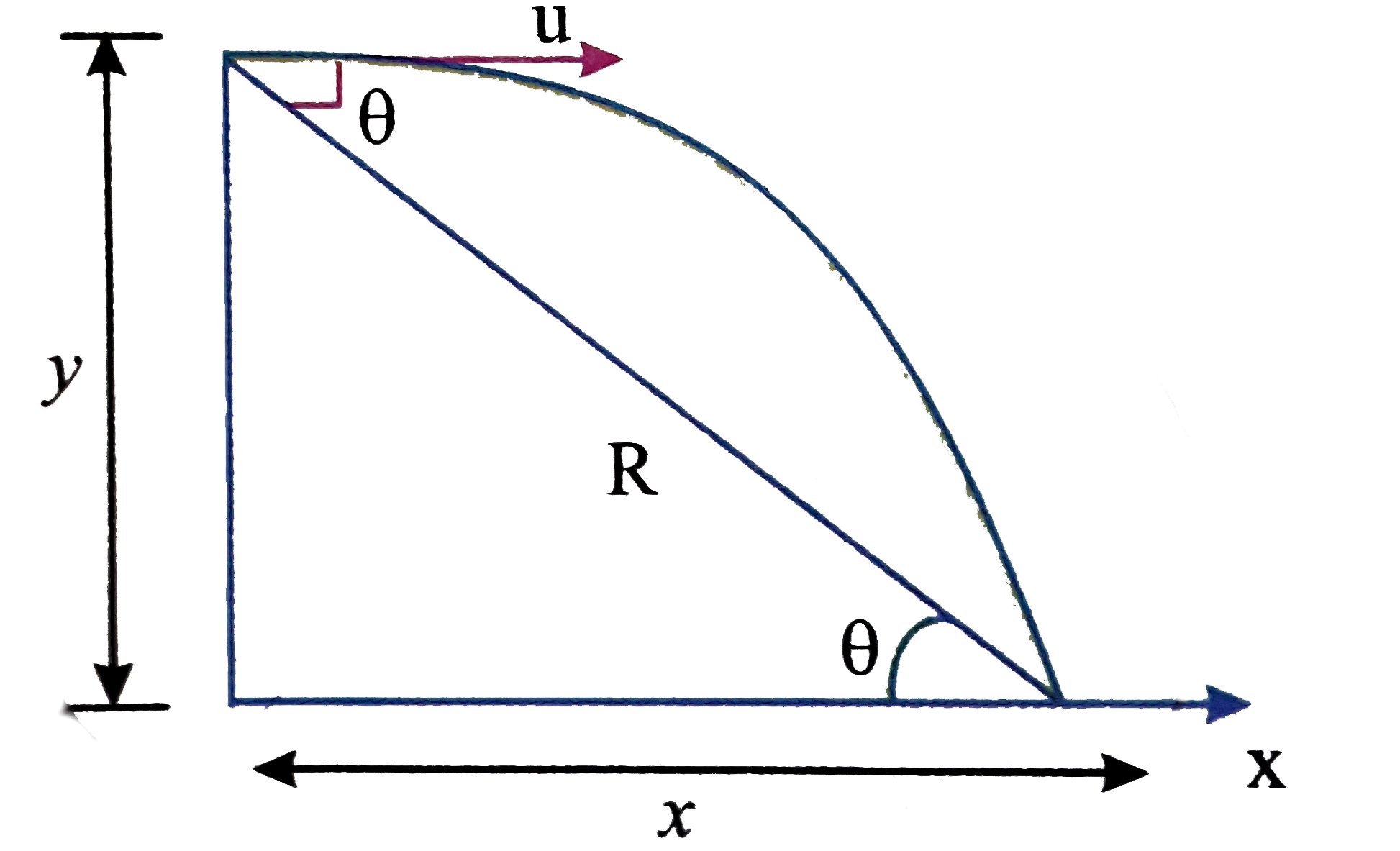A particle is projected with a speed u. If after 2 seconds of projection it is found to be making an angle of 45∘ with the horizontal and 0∘ after 3 sec, then:
Angle of projection is tan−13
Angle of projection is tan−1(1/3)
Speed of projection =30√2m/s
Speed of projection is 30 m/s
The correct Answer is:A
To solve the problem step by step, we will analyze the motion of the particle projected at an angle and use the information given about its velocity at specific times.
Step 1: Understand the components of motion
The particle is projected with an initial speed u at an angle θ. The initial velocity can be broken down into horizontal and vertical components:
- Horizontal component: ux=ucosθ
- Vertical component: uy=usinθ
Step 2: Analyze the vertical motion at t=3 seconds
At t=3 seconds, the particle is at an angle of 0∘ with the horizontal, which means its vertical component of velocity vy is 0:
vy=uy−gt=0
Substituting t=3 seconds:
usinθ−g⋅3=0
Rearranging gives:
usinθ=3g
Using g≈10m/s2:
usinθ=30m/s(1)
Step 3: Analyze the vertical motion at t=2 seconds
At t=2 seconds, the angle with the horizontal is 45∘. The tangent of the angle is given by:
tan(45∘)=1=vyux
The vertical component of velocity at t=2 seconds is:
vy=usinθ−g⋅2=usinθ−20
Setting this equal to ucosθ (since tan(45∘)=1):
usinθ−20=ucosθ
Rearranging gives:
usinθ−ucosθ=20
Factoring out u:
u(sinθ−cosθ)=20(2)
Step 4: Solve the equations
Now we have two equations:
1. usinθ=30
2. u(sinθ−cosθ)=20
From equation (1), we can express sinθ:
sinθ=30u
Substituting this into equation (2):
u(30u−cosθ)=20
This simplifies to:
30−ucosθ=20
Thus:
ucosθ=10(3)
Step 5: Find tanθ
Now we have:
- From (1): usinθ=30
- From (3): ucosθ=10
Now we can find tanθ:
tanθ=usinθucosθ=3010=3
Thus:
θ=tan−1(3)
Step 6: Find the initial speed u
To find u, we can use the Pythagorean theorem:
u2=(usinθ)2+(ucosθ)2
Substituting the values:
u2=302+102=900+100=1000
Thus:
u=√1000=10√10m/s
Final Answers
- The angle of projection θ=tan−1(3)
- The speed of projection u=10√10m/s
The particle is projected with an initial speed u at an angle θ. The initial velocity can be broken down into horizontal and vertical components:
- Horizontal component: ux=ucosθ
- Vertical component: uy=usinθ
At t=3 seconds, the particle is at an angle of 0∘ with the horizontal, which means its vertical component of velocity vy is 0:
vy=uy−gt=0
Substituting t=3 seconds:
usinθ−g⋅3=0
Rearranging gives:
usinθ=3g
Using g≈10m/s2:
usinθ=30m/s(1)
At t=2 seconds, the angle with the horizontal is 45∘. The tangent of the angle is given by:
tan(45∘)=1=vyux
The vertical component of velocity at t=2 seconds is:
vy=usinθ−g⋅2=usinθ−20
Setting this equal to ucosθ (since tan(45∘)=1):
usinθ−20=ucosθ
Rearranging gives:
usinθ−ucosθ=20
Factoring out u:
u(sinθ−cosθ)=20(2)
Now we have two equations:
1. usinθ=30
2. u(sinθ−cosθ)=20
sinθ=30u
Substituting this into equation (2):
u(30u−cosθ)=20
This simplifies to:
30−ucosθ=20
Thus:
ucosθ=10(3)
Now we have:
- From (1): usinθ=30
- From (3): ucosθ=10
tanθ=usinθucosθ=3010=3
Thus:
θ=tan−1(3)
To find u, we can use the Pythagorean theorem:
u2=(usinθ)2+(ucosθ)2
Substituting the values:
u2=302+102=900+100=1000
Thus:
u=√1000=10√10m/s
- The angle of projection θ=tan−1(3)
- The speed of projection u=10√10m/s
Topper's Solved these Questions
- Motion in Two DimensionsBook:VMC MODULES ENGLISHChapter:Motion in Two DimensionsExercise:JEE Main (Archive)
Explore 19 Videos
- Motion in Two DimensionsBook:VMC MODULES ENGLISHChapter:Motion in Two DimensionsExercise:JEE Advanced (Archive)
Explore 19 Videos
- Motion in Two DimensionsBook:VMC MODULES ENGLISHChapter:Motion in Two DimensionsExercise:Long Answer Type
Explore 5 Videos
- Motion in Straight Line Book:VMC MODULES ENGLISHChapter:Motion in Straight Line Exercise:IN-CHAPTER EXERCISE-J
Explore 10 Videos
- MOVING CHARGES & MAGNETISM Book:VMC MODULES ENGLISHChapter:MOVING CHARGES & MAGNETISM Exercise:IN-CHAPTER EXERCISE-K
Explore 10 Videos
Similar Questions
A particle is projected in the X−Y plane. 2sec after projection the velocity of the particle makes an angle 45∘ with the X−axis. 4sec after projection, it moves horizontally. Find the velocity of projection (use g=10ms−2).
View SolutionA particle is projected horizontally with a speed u from the top of plane inclined at an angle θ with the horizontal. How far from the point of projection will the particle strike the plane ?

View Solution
Knowledge Check
A particle is projected at time t=0 from a point P on the ground with a speed v0, at an angle of 45∘ to the horizontal. Find the magnitude and direction of the angular momentum of the particle about P at tiem t=v0/g
Aa. mv302√2gBb. mv30√2gCc. 3mv30√2gDd. √2mv30g
A stone is projected with speed u and angle of projection is θ. Find radius of curvature at t=0.
View SolutionA particle is projected with a speed 10√2 making an angle 45∘ with the horizontal . Neglect the effect of air friction. Then after 1 second of projection . Take g=10m/s2.
View SolutionA particle is projected in the x-y plane with y-axis along vertical. Two second after projection the velocity of the particle makers an angle 45∘ with the X-axis. Four second after projection. It moves horizontally. Find velocity of projection.
View SolutionA ball is projected from the ground at angle θ with the horizontal. After 1s, it is moving at angle 45∘ with the horizontal and after 2s it is moving horizontally. What is the velocity of projection of the ball ?
View SolutionA particle is projected at an angle θ with an initial speed u.
View SolutionA ball is projected horizontal from the top of a tower with a velocity v0. It will be moving at an angle of 60∘ with the horizontal after time.
View SolutionA particle of mass m is projected with a velocity v making an angle of 45∘ with the horizontal. The magnitude of the angular momentum of the projectile abut the point of projection when the particle is at its maximum height h is.
View Solution